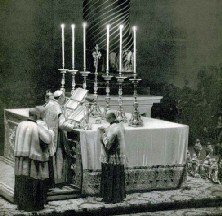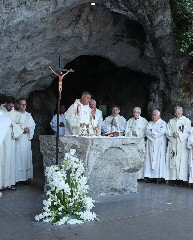

|
|
| Musical Musings: Liturgy |
|
|
Where Are the Books of Propers?This article, which appeared as a January 21, 2010, posting on the blog New Liturgical Movement, is reprinted with the kind permission of the author, Jeffrey Tucker.
Change is in the air! However, somehow, the hymnals that accompany the Mass will not be changing much. They will be stuffed from front to back with hymns — some old, some new, and the entire collection bearing the mark of the vaunted committee behind what is in and what is out. It is all a compromise of various cultural, economic, and intellectual interests, and this compromise will drive forward the sound and feel of Mass every week for years to come in parishes across America. What's wrong with this picture? Well, if you look at the actual Mass and its music, you find very few examples of what we now call hymns. There are sequences that are highly scripted with a fixed text and melody. There are a few other such hymn events sprinkled throughout the year. But there is nothing in the Roman Rite that calls for a hymn of your choice (randomize that iPod!) at the entrance, offertory, communion, and recessional. You can look and look and find nothing like that in the structure of the Mass. The hymn mania stems from a last option choice permitted in the GIRM's rubrics, but the Vatican has used the term "tragedy" to describe the replacement of proper texts with hymns. The root of the problem has preconciliar origins, when the Vatican permitted Low Mass to use vernacular hymns, and here is where emerged the famed four-hymn sandwich that we know all too well. The Second Vatican Council hoped to do something about the problem by insisting that the chants of the Mass be given first place at Mass. This means singing the propers of the Mass. Why should we sing the propers? Because they are integral to the Mass itself, as much as any of the prayers of the Mass. As Hungarian scholar Laszlo Dobszay has demonstrated through extensive study, the essential core of the arrangement of the proper texts and the music for them actually dates from the 7th century. This isn't some new discovery. In fact, Dobszay, writing in the Spring 2007 issue of Sacred Music, further shows that there is a continuous tradition of the propers in the Roman Rite — stable all over the world from the 7th century to the 20th century. "The repertory and distribution of the proper chants per anni circulum... is an integral part of the Roman rite. The system as a whole was common throughout the universal Roman rite, accepted everywhere and at every epoch from the earliest documented beginnings until the final decades — even if some few pieces were fixed in their place by the tradition of a local church institution such as a diocese or a religious order." "In other words, the chant was not merely an accompaniment but an important component of the liturgy, indeed, of the daily liturgy. The chants had their function in delivering the contents of the liturgy. In other words: to the liturgy of a given day there belong the chant texts, no less than the prayers and lections, and therefore omission of the daily chanted texts mutilates and truncates the message of the liturgy." The Council Fathers at Vatican II knew what was up with this. There was a precise reason for the wording of the music passages in Sacrosanctum concilium of 1963. The idea was to move away from vernacular hymnody and toward the propers, that is toward singing the Mass as it is given. The document Musicam sacram of 1967 even provided a roadmap, step by step — an attempt to get every parish on board with the program. The new Missal of 1970 was promulgated with propers in a new arrangement for the new calendar. The music books were published a few years later. And yet here we are, nearly half a century after the Vatican and a Church Council (there is no higher authority than God) sought the replacement of vernacular hymns with propers, and what do we find in the typical parish? A plethora of vernacular hymns replacing the Introit, Gradual, Offertory, and Communion chants. It is mind bogging.
Might the propers have been translated to English? Of course this can happen. The result is not Gregorian chant but at least it can share in the spirit of chant. The Anglicans have been doing this for hundreds of years. You can write new melodies in plainchant, render Gregorian melodies in English, simplify tradition chants to accommodate vernacular, or sing them all in simple psalm tones. You can even use choral propers. These are all options. Not all exclude the people. There are some wonderful challenges here that can be taken up. If you knew nothing about reality other than the dictates of Church legislation from the 1960s, and were asked to speculate about what kinds of books music publishers were publishing by the 1990s, you might assume that there would be a myriad of books with propers in them using all the above options. There would be the Joncas Gradual, the Schutte Book of Simple Propers, the Haugen Tone Psalter, or whatever, among a hundred others. But those books do not exist. What the current books do is take the worst example of preconciliar hymn gluttony and expand upon it, displacing propers altogether! It is a strange reality. But, you know, you live and learn, and surely 40-50 years is long enough to err and to enter onto the path of truth in ritual. And yet we are in 2010, finally getting around to fixing translation problems with the Mass text, and the new hymnals being rolled out repeat exactly the same error! The whole thing is amazing. In their defense, companies like GIA and OCP and Liturgical Press are not official Church publishers. They are for-profit and non-profit private companies that are just trying to meet a need, as they see it. They are not leading. They are following what they perceive as consumer demand. Now, I have a problem with this model of publishing. I have no doubt that the publishers would change if they sensed a consumer groundswell for propers. And yet, a religious publisher must have a reason for existence besides simply giving people what they want. They do have responsibilities that are broader: to teach, to lead, to provide what is appropriate. So, no, I don't think they can be let off the hook entirely here. But there other factors that have kept propers at bay. In the sixties, the cultural times seemed to call for goofy folk sing alongs, music that emphasized the supposed sense of the people rather than a sense of the faith. It was a weird time, and best forgotten. Sadly, these times are not forgotten but re-lived every week in parish liturgy. We just can't seem to let the 60s and 70s go, even as the rest of the world has moved on. Thinking about this more, one also wonders why the Catholics didn't follow the path that the Anglicans took hundreds of years ago and put together vernacular music books of propers. I don't know the answer but it might have something to do with the resistance in the Catholic world toward all things Anglican — a sort of cultural rift that led Catholics to attempt to reinvent a wheel that turned out not to be round. The problem was not helped by the partisans of Gregorian chant, who understandably (and perhaps rightly!) took an uncompromising attitude that the proper chants of antiquity should not be sliced and diced and thereby destroyed just to accommodate the supposed needs of "modern man." I can understand that point of view. But it left a vacuum filled by people who thought that stuff made up around the campfire was perfectly suitable for liturgy. And so, it was a perfect storm. And look where we are today. The grand and great tradition of proper texts that extended from the 7th to the 20th century has been mutilated and forgotten, and we are stuck, again and again and again, in this same sing-along mode that has no normative precedent in the whole history of our faith. And now, we are doing it to ourselves yet again — buying these doorstop-sized books of hymns, opening them up week after week, and calling it all Catholic without the slightest bit of evidence. You think the transition to sound ritual would be hard? Here's what is most surprising. It is not hard. It is easy. It could not be easier. There are many vernacular books of propers online for free download. The Musica Sacra website has dug them up and given them away for the whole Church. These can be sung this coming Sunday! The Latin versions are also free. There are seminars and training camps going on every month that train people in singing the propers. It can be done. It is a matter of making the choice: shall we do the Roman Rite or should we participate in a ritual of our own invention? Jeffrey Tucker is Managing Editor of Sacred Music magazine |
 And so the fun begins.
Catholic music publishers are rolling out their new hymnals in preparation for the new translation of the Mass that is in the final stages.
The word translation here is important because that is what it is, in contradistinction to what we use now, which is an often-loose paraphrase of the Latin.
The very prospect of a real translation lifts the heart!
Soon our liturgy programs can feature parallel Latin/English and it will make some sense to us.
And so the fun begins.
Catholic music publishers are rolling out their new hymnals in preparation for the new translation of the Mass that is in the final stages.
The word translation here is important because that is what it is, in contradistinction to what we use now, which is an often-loose paraphrase of the Latin.
The very prospect of a real translation lifts the heart!
Soon our liturgy programs can feature parallel Latin/English and it will make some sense to us.
 In the 1960s, when this program of fixing the problem was under way, there was an additional complication that Gregorian chant was being pushed at the same time that vernacular was in vogue.
As Fr. Anthony Ruff has often pointed out, there were pressures in this period that were working at cross purposes.
In the 1960s, when this program of fixing the problem was under way, there was an additional complication that Gregorian chant was being pushed at the same time that vernacular was in vogue.
As Fr. Anthony Ruff has often pointed out, there were pressures in this period that were working at cross purposes.